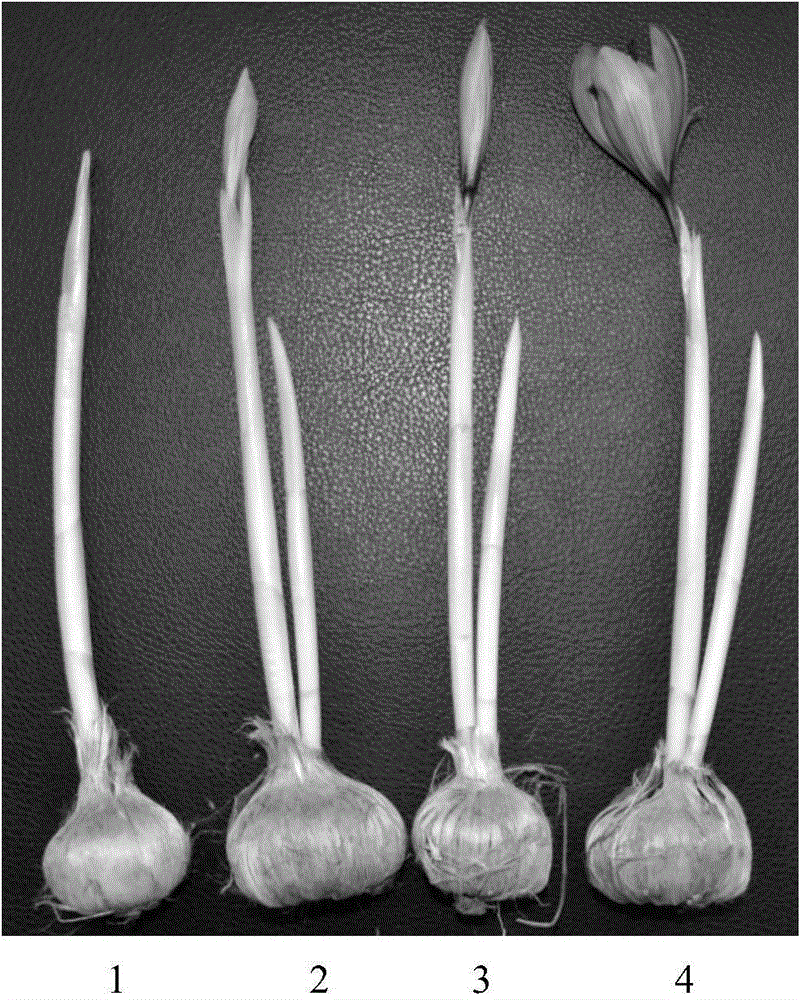Production processing method for crocus sativus
A processing method and technology for saffron, which are applied in botanical equipment and methods, fruit hanging devices, horticulture and other directions, can solve the problems of improper processing technology, low content of saffron, late flowering and unfavorable rooting and rejuvenation of bulbs, and the like, Achieve early rooting, improve quality and value, and facilitate the effect of strong seedlings
- Summary
- Abstract
- Description
- Claims
- Application Information
AI Technical Summary
Problems solved by technology
Method used
Image
Examples
Embodiment 1
[0027] Method for artificially breaking dormancy of saffron
[0028] Since mid-May 2014, 100 saffron bulbs were selected and cultivated on shelves indoors. The room temperature was controlled at about 25°C and the light was mainly light and dark; Seal the bag and place it in a refrigerator at 4°C for 1 month at low temperature; from mid-August to mid-September, put the saffron on the shelf and continue to place it indoors to avoid light for cultivation. The indoor temperature is controlled at about 25°C and the relative humidity is 80%; September From mid-October to mid-October, control the indoor temperature to around 22°C, relative humidity to 80%, and avoid light; from late October to mid-November, control the indoor temperature to around 16°C, relative humidity to 75%, and no shading indoors.
[0029] Another control group was set up, and 100 saffron bulbs were selected, which were not treated with artificial low-temperature breaking dormancy, and all were cultivated indoo...
Embodiment 2
[0032] Effects of different flower picking periods on the content of crocin in finished silk products
[0033] In November 2014, flowers of different flowering stages ( figure 1 ), select four time points for the flowering period: 3 days before flowering (-3d), 2 days before flowering (-2d), 1 day before flowering (-1d), and flowering period (0d). Flowers at anthesis (0d) were used as controls. Separate the filaments, and dry the filaments in an oven at 100°C. According to the method stipulated in "Chinese Pharmacopoeia", the content of crocin in saffron filaments at different flowering stages was determined. The standard products of crocin I and crocin II were purchased from Shanghai Jingke Chemical Technology Co., Ltd. The measurement results are as follows:
[0034] flowering period
[0035] 0d
[0036] It can be seen that the content of crocin in filaments is different at different flowering stages, and the content is the highest 3 days before flowe...
Embodiment 3
[0038] Effects of Different Drying Temperatures on the Content of Crocin in Filigree Finished Products
[0039]In November 2014, the flowers 2 days before flowering were selected, the filaments were separated, and different drying temperatures (40°C, 60°C, 80°C, 100°C) were set, and the filaments were dried in an oven. According to the method stipulated in "Chinese Pharmacopoeia", the influence of different drying temperatures on the content of crocin in saffron filaments was determined. The standard products of crocin I and crocin II were purchased from Shanghai Jingke Chemical Technology Co., Ltd. The measurement results are as follows:
[0040] drying temperature
[0041] It can be seen that the content of crocin is the highest at 100°C, reaching 38.58%, which is 3 percentage points higher than other drying temperatures. The three drying temperatures of 40°C, 60°C and 80°C did not change the content of crocin significantly, and the content was slightly higher at...
PUM
 Login to View More
Login to View More Abstract
Description
Claims
Application Information
 Login to View More
Login to View More - R&D
- Intellectual Property
- Life Sciences
- Materials
- Tech Scout
- Unparalleled Data Quality
- Higher Quality Content
- 60% Fewer Hallucinations
Browse by: Latest US Patents, China's latest patents, Technical Efficacy Thesaurus, Application Domain, Technology Topic, Popular Technical Reports.
© 2025 PatSnap. All rights reserved.Legal|Privacy policy|Modern Slavery Act Transparency Statement|Sitemap|About US| Contact US: help@patsnap.com

